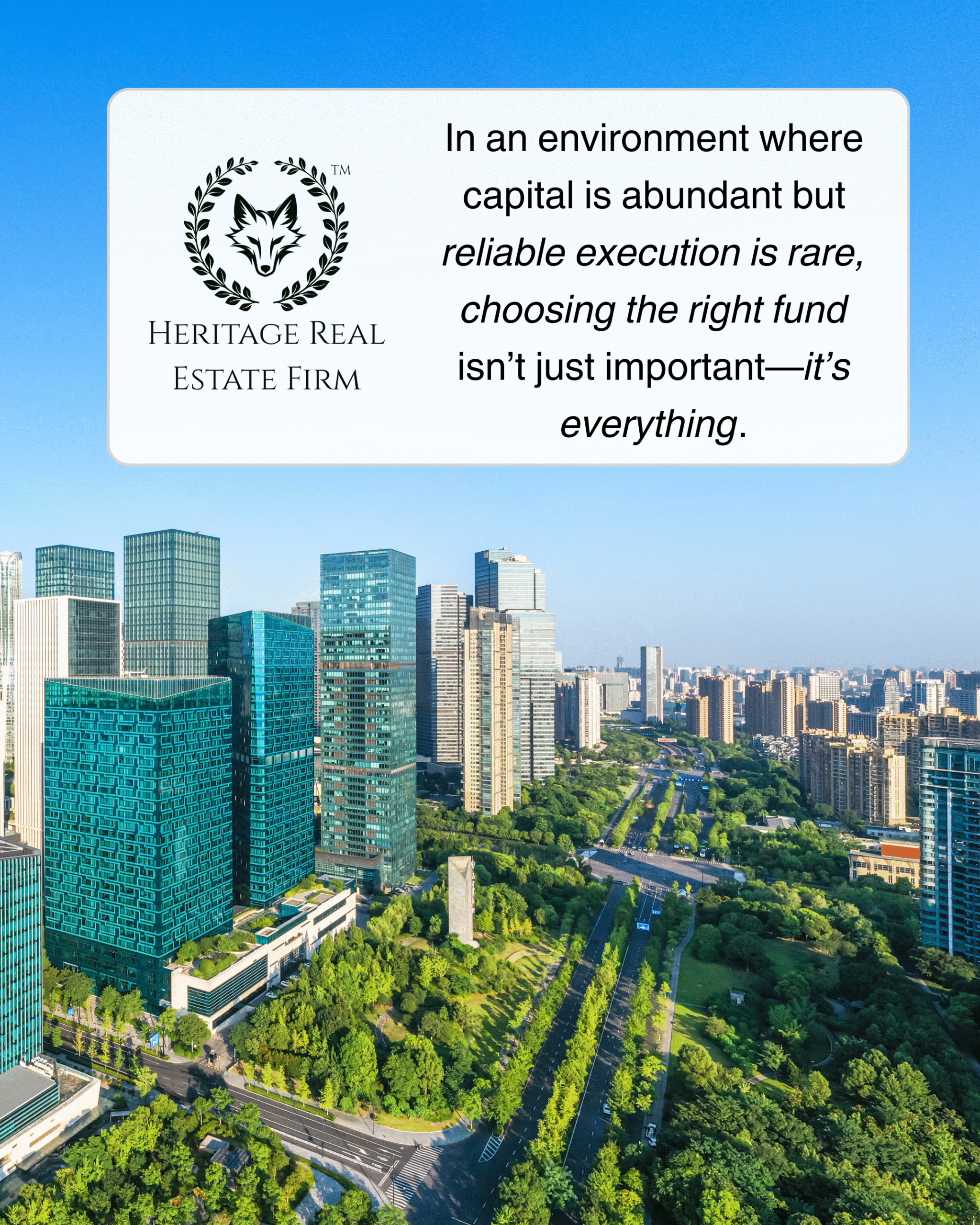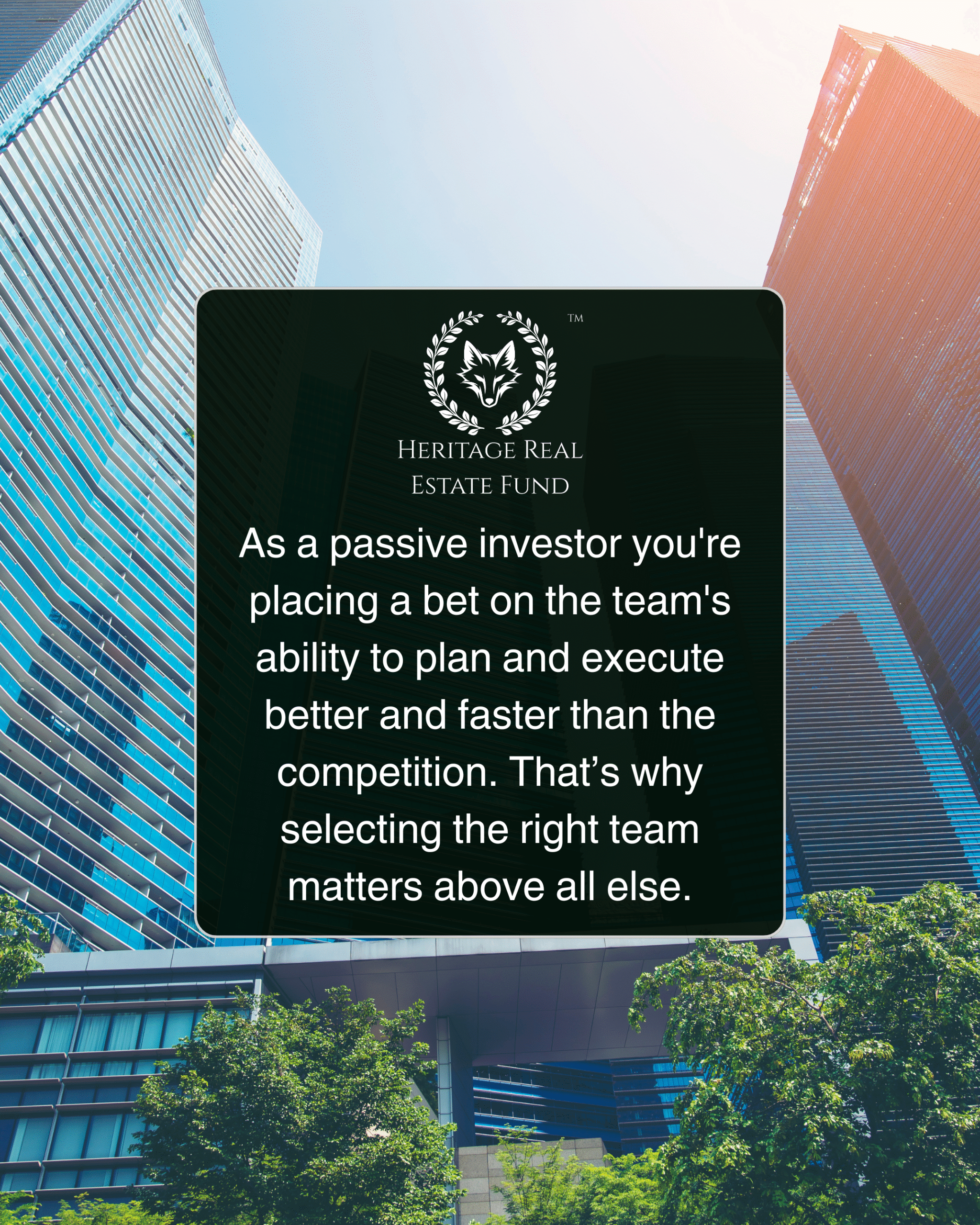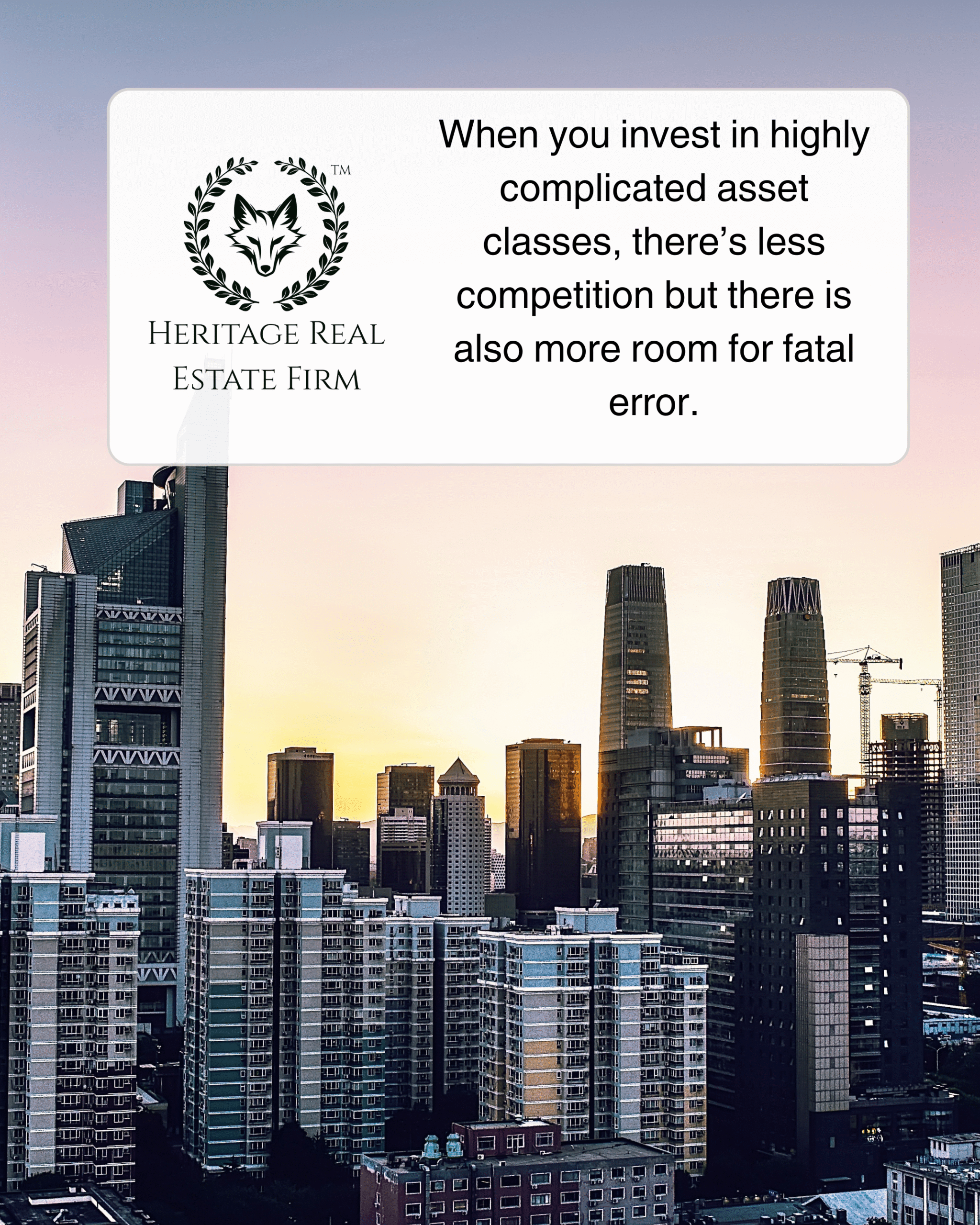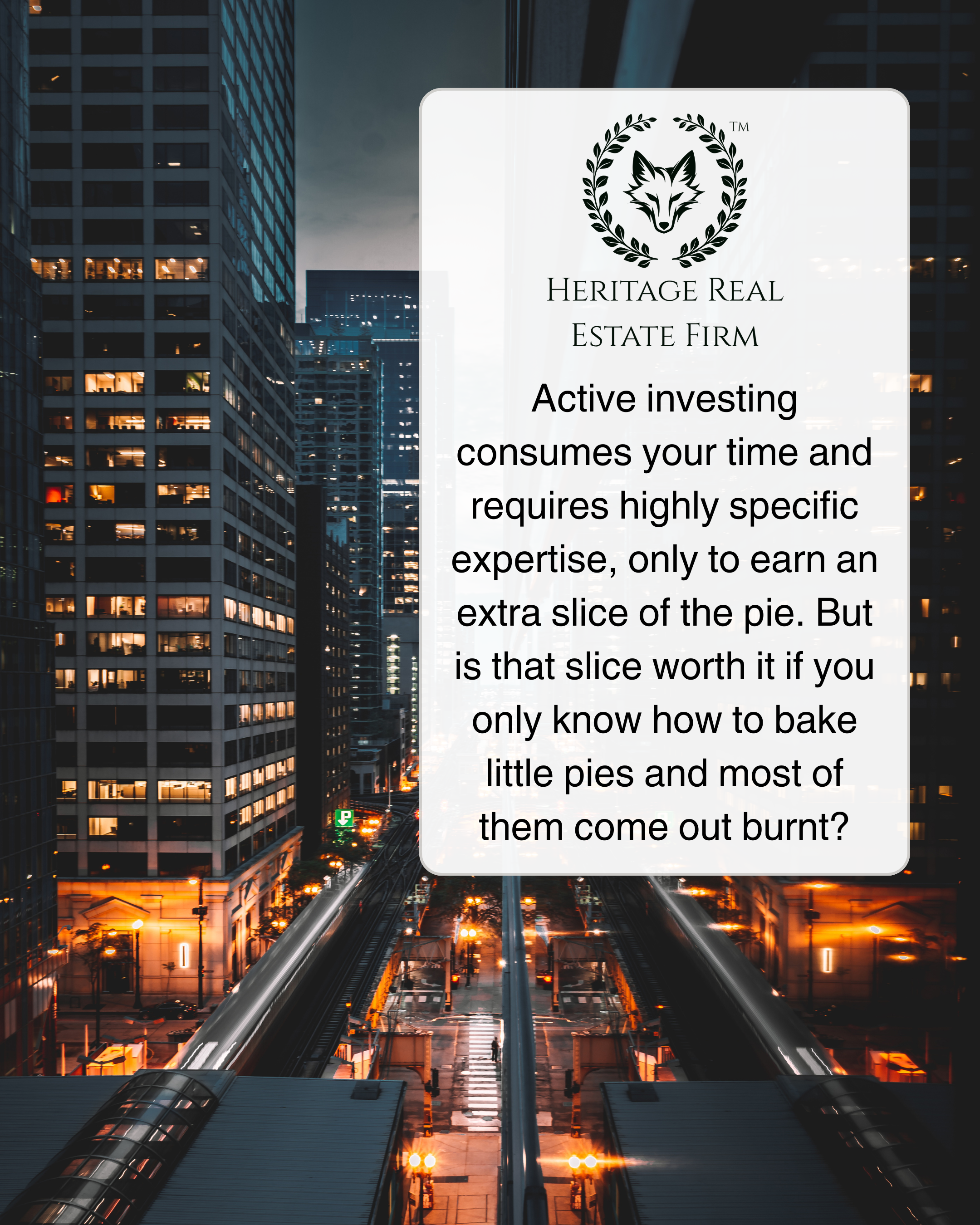
Investing Passively vs. Actively
When you invest in highly complicated asset classes, there’s less competition, but there is also more room for fatal error.
Maximizing returns comes down to execution.
Execution is where value is created.
Deal sourcing and market insights are not enough.
What is your leasing strategy?
What is your track record?
How will you mitigate risk?
These are the critical questions every investor must ask—especially if considering a passive investment or planning to take an active role. The distinction between passive and active investing isn’t just about time or effort—it’s about control, responsibility, and ultimately, outcomes.
The Passive Investor: Outsourcing Execution
Passive investing allows you to leverage the experience, relationships, and infrastructure of a team like ours, for a paltry management fee which is nominal compared to the returns our investors experience.
In private equity real estate, venture capital, and other complex asset classes the best investors count on a high barrier to entry—not just financially, but operationally.
As a passive investor, your primary responsibility is due diligence. Who are you investing with? What is their track record in similar deals? Do they have a verifiable advantage in sourcing, executing, or managing assets? Have they consistently picked winners, even in downturns?
You’re placing a bet not only on the market but also on the team’s ability to execute. Their leasing strategy, capital stack decisions, and exit planning are all outside your control. That’s why selecting the right team matters above all else.
The Active Investor: Owning the Execution
Active investing means you’re directly involved in deal sourcing, underwriting, negotiating, asset management, and exit strategies. This path offers more control—and, theoretically, more upside. But it also exposes you to more risk, especially in asset classes that require deep expertise. How certain are you of the market’s trajectory? Have you survived a downturn? What will you do to mitigate risk?
When you lead the show, you are responsible for the playbook. You must anticipate the market shifts, execute on leasing or repositioning strategies, manage contractors, maintain compliance, and control the budget. This requires not just skill, but a seasoned team and operational infrastructure.
In a competitive market, your edge is your ability to execute a better plan, better than others. The returns you generate are a direct result of your decision-making under pressure.
Here are several stories of inexperienced individuals who tried to go it alone in complex commercial real estate deals—without the team, strategy, or experience needed to succeed. Their names have been concealed to protect their identities.


The Wrong Office – Lost $12 Million
Who:
A successful entrepreneur who sold his tech company and decided to “diversify” into commercial real estate.
What happened:
He bought a mid-sized office building in a second-tier city, betting on a “post-COVID office rebound.” He wrongly assumed all office tenants are equal. An expert investor would’ve known which office buildings refill first and fast after a recession. He did not. He also underestimated how long it would take to lease up a vacant office building in a non-critical location. Because of this, he overpaid for an asset with declining fundamentals.
Where it went wrong:
- No leasing strategy.
- No local broker relationships.
- Ignored market comps.
- Interest rates rose causing cash flow to disappear which meant he defaulted on the bridge loan.
Outcome:
Instead of investing $12MM with an experienced team and earning a solid return, he chose to avoid a modest management fee—and ended up losing the entire $12MM of his own capital, along with his credibility in investor circles.

The Industrial Spec Build Nightmare – Bankruptcy Filing
Who:
A mid-level executive who liquidated his 401(k) to build two warehouses on spec in a fast-growing Sunbelt submarket.
What happened:
Without looking at key market data that any demographer would start their search with, he assumed “if I build it, Amazon will use it.” He chose a location that was too far from the key points of the local supply chain. Amazon and local logistics companies did not line up to lease his product.
Where it went wrong:
- He never validated tenant demand
- He didn’t take time to learn the intricacies of industrial site selection.
- Construction delays and cost overruns destroyed his budget.
- Tenant interest never materialized.
Outcome:
He didn’t just lose the 401(k) he had spent decades building—he also ruined his credit, wasted two years chasing a failed venture, and ultimately had to file for personal bankruptcy, which black-listed him from high-paying executive roles for seven years.
These cautionary tales highlight why sophisticated funds like HREF exist—to protect investors from these fatal missteps by providing experienced execution, proven underwriting, and institutional-grade asset management.
The Self-Storage Meltdown – Foreclosure in 18 Months
Who:
A dentist who partnered with two friends to buy a self-storage facility after watching a few YouTube videos.
What happened:
They bought an aged, underperforming property assuming they’d “just renovate and raise rents.”
Where it went wrong:
- They didn’t realize the local market had three new self storage projects under construction.
- They couldn’t hit break-even occupancy and had no operating experience or connections to help bring costs down or increase revenue.
Outcome:
Instead of investing $1.2MM with an experienced team and earning a solid return, they wanted to avoid a modest management fee—and ended up foreclosed on by the lender, all three lost their $1.2MM down payment.

The Luxury Retail Gamble – One Tenant Destroyed It All
Who:
A high-net-worth investor from NYC bought a retail center in Miami with one anchor tenant.
What happened:
The anchor tenant (a boutique fashion brand) closed six months after acquisition due to corporate restructuring.
Where it went wrong:
- He relied on the strength of a single tenant
- Did not know enough about the industry to set up backup plans or co-tenancy clauses.
- He also had zero leasing relationships to find timely replacements.
Outcome:
With the anchor gone, foot traffic collapsed, small tenants left, and NOI dropped 80%. As a result, asset value tanked so that he could not refinance or sell. In the end, he lost $6MM equity.


The Trade-Off: Risk, Time, and Equity
Both approaches can (in theory) build wealth—but they require completely different skill sets, mindsets, connections, knowledge and experience.
Passive investing allows you to leverage your time and connections to have money work for you while you sleep, travel and spend time with those you love. Active investing consumes your time and requires highly specific expertise, only to earn an extra slice of the pie. But is that slice worth it if you only know how to bake little pies and most of them come out burnt?
If you’re a CRE expert who loves to spend their time sourcing deals, managing renovations and negotiating leasing agreements, active investing may make sense for you. If you’re a high-net-worth individual with limited time but strong capital and a desire to mix capital preservation with long term growth opportunities, aligning with a best-in-class fund like HREF is clearly the win-win opportunity you’ve been looking for.
Execution is where value is created—and whether you’re executing personally or evaluating someone else’s execution, your returns will reflect how well that part is handled.
Legal Disclaimer: This content is for informational purposes only and does not constitute investment advice, an offer, or a solicitation to invest. Past performance is not indicative of future results. Please consult your financial, legal, or tax advisor to determine whether any investment opportunity is appropriate for your personal circumstances. Heritage Real Estate Fund (HREF) offerings are available to accredited investors and are conducted under SEC Regulation D, Rule 506(c).


